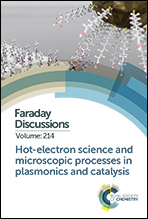Assistance of metal nanoparticles in photocatalysis – nothing more than a classical heat source
Abstract
In a recent paper, we derived a self-consistent theory of the steady-state electron distribution of a metal under continuous wave illumination which treats thermal and non-thermal effects on the same footing. Here, we re-derive the main analytical results of that study from very simple arguments, and draw a series of conclusions which contradict claims made in previous studies of the steady-state distribution. In particular, we show that the faster chemical reactions reported in many previous papers are extremely unlikely to originate from high energy non-thermal electrons. Instead, the faster reactions very likely originate from a purely thermal effect.

- This article is part of the themed collection: Hot-electron science and microscopic processes in plasmonics and catalysis


 Please wait while we load your content...
Please wait while we load your content...